You might also want to
P9927 Product Used Image Gallery
Neoclassical Villa Exterior with Polyurethane Cladding and Elegant Facade Design
Neoclassical Elegance with Polyurethane Facade ElementsThis villa exterior demonstrates the refined appeal of polyurethane cladding in harmony with neoclassical architectural traditions. The balanced symmetry of the facade, along with ornate molding details, creates an elevated sense of style and sophistication. Slender vertical lines and carefully placed recessed panels create a rhythm that highlights the villa's grandeur.The tall windows with wrought iron railings open the interior to natural light while expressing a strong vertical emphasis. The central entrance is framed with pilasters and completed with an arched transom window, introducing a focal point that reflects centuries-old traditions of European villa design. Polyurethane elements lend the opportunity to craft precise shapes and delicate motifs that withstand time and weather.Classical Motifs and Decorative DepthSubtle decorative ornaments, such as floral railing designs and fluted pilasters, connect the modern build with historical influences from ancient Roman and Renaissance villa facades. The roof is accented with dormer-type openings and a balustrade crowning, adding detail to the skyline silhouette of the structure. Lighting fixtures integrated into the facade emphasize the architectural textures during the evening, transforming the villa into a visually striking landmark.Throughout history, architectural orders like Doric, Ionic, and Corinthian have inspired such proportions and motifs. In this modern adaptation, polyurethane achieves the ornamental depth of those classical traditions while providing practical efficiency in installation and weather resistance. The villa seamlessly bridges heritage and modern lifestyle.Durable polyurethane exterior decorationRefined neoclassical proportionsBalanced symmetry and elegant window structuresWrought iron balconies with decorative motifsGrand entrance with arched transom window This neoclassical villa exterior uses polyurethane cladding for refined detailing. The grand facade highlights symmetry through tall arched and rectangular windows. Elegant wrought iron balconies add charm and sophistication. The entryway features pilasters and a prominent arched window. Vertical fluting and recessed panels create depth. Ornamental motifs enhance its timeless elegance. Roof dormers and balustrades accentuate the skyline. Evening lighting highlights architectural reliefs effectively. Landscaping integrates ornamental greenery with balance. Outdoor pathways lead to a welcoming entry statement. Classical traditions inspire modern adaptations throughout the design. Polyurethane elements ensure both durability and fine detail. Historical influences meet practical building technology seamlessly. This exterior style blends tradition with comfort. The result is a villa facade radiating dignity, harmony, and refinement.
The Most Trendy Exterior Villa Designs
Villa Exterior Design with Neoclassical Polyurethane Products Bring Elegance and Durability Together Neoclassical style architecture allows reinterpretation of classical lines with modern touches Polyurethane decorative elements used in villa exteriors attract attention with both their aesthetic appearance and durability Light, long-lasting and easy-to-apply polyurethane products add an elegant and eye-catching air to the exterior of your villa Neoclassical polyurethane exterior decorations include details such as columns, arches, cornices, plasterboards and window frames These decorative elements add magnificence to the structure while also being highly resistant to water, moisture and external weather conditions Compared to traditional materials such as wood or plaster, they do not require maintenance and maintain their first-day elegance for many years Polyurethane products used in neoclassical exterior design offer personalized solutions to villa owners Thanks to different pattern size and color options, it is possible to add aesthetic touches suitable for every structure In addition, thanks to their lightweight structure, they are easy to install and do not increase the static load of the structure If you want to add a timeless elegance and sophisticated look to the exterior of your villa, neoclassical polyurethane decorative products will be a perfect choice This design approach that brings together both traditional and modern elements gives your villa a unique identity
Neo-Classical Modern Villa Exterior with Polyurethane Decorative Elements
Neo-Classical Villa Exterior with Polyurethane DetailsThe exterior design of this villa demonstrates the harmony between neo-classical features and modern living standards. Prominent pilasters, decorative cornices, and polyurethane ornaments define the façade’s elegance. Large arched windows framed with finely crafted moldings emphasize verticality, while wrought iron balcony railings add artistic integrity.The columns beside the entrance recall ancient classical architecture, evoking the dignity of Roman and Greek construction traditions. Historically, such columns symbolized durability and proportion, and here they are reinterpreted to suit a contemporary villa.Decorative panels and geometric frames establish a strong visual rhythm across the façade. The soft gray walls paired with a contrasting dark roof create a serene yet powerful composition. Polyurethane elements allow intricate motifs such as relief borders and cornice detailing to appear with sharp precision while maintaining durability.Additional features include symmetrical lighting sconces flanking the doors, accentuating nighttime appeal. The rooftop terrace expands functional space without disrupting the villa’s aesthetic order. These details unite to form an exterior that is both grand and inviting, showcasing a balanced blend of modern villa design and a classic style approach.Geometric frames highlight structural balance.Arched windows emphasize elegance.Polyurethane elements ensure durability and detail accuracy.Columns and cornices enrich the façade with depth and shadow. This neo-classical villa exterior merges grandeur with modern precision. Decorative polyurethane details highlight the façade. Tall arched windows create a sense of openness and light. Wrought iron balcony railings emphasize elegance. Vertical pilasters balance with crisp horizontal cornices. The soft gray walls contrast with the dark roof shingles effectively. Lighting features add architectural character during the evening. The entrance is framed by columns reflecting classical traditions. Detailed geometric frames enrich the overall rhythm of design. Polyurethane elements ensure refined durability. The rooftop terrace provides functionality in style. Arched compositions recall classical architectural heritage. The harmonious façade reflects timeless sophistication. This villa combines classical architecture with modern villa design. Distinctive polyurethane details complete the aesthetic impression.
Elegant Polyurethane Exterior Design for Classic Villas with Ornamental Details
Polyurethane Exterior EleganceThe exterior of the villa showcases the versatile use of polyurethane in creating classic architectural features such as balustrades, cornices, and detailed ornamental motifs. The pristine white façade emphasizes symmetry, with repetitive spindle balusters forming strong geometric rhythms. The integration of polyurethane ensures a lightweight yet durable solution compared to natural stone.The balcony railings are enriched with spindle designs that echo Renaissance and Baroque aesthetics, enhanced by golden accents on the Corinthian-like column capitals. This detail transforms structural elements into decorative highlights while reinforcing the luxurious identity of the building. On the façade, floral and vine patterns add visual fluidity, contrasting the rigid geometric forms of the grid-patterned windows.Historic Influence and Timeless StyleThroughout history, column capitals and repeating balusters symbolized grandeur and sophistication, seen in Roman and later European architecture. By using polyurethane, this villa design reinterprets those qualities for a contemporary setting, avoiding issues of weight and weathering associated with stone.The design emphasizes symmetry, ornamentation, and craftsmanship, creating a seamless fusion of durability and beauty. The roofline with its dark contrast frames the ornate white façades, adding balanced proportionality. Golden decorative inserts highlight capitals and corbels, enhancing the sense of refinement. Together, these elements offer a sustainable and elegant solution for modern villas that still seek inspiration from classical traditions. This villa exterior highlights polyurethane as a versatile material applied to classical design. The white balustrades show spindle-shaped patterns with careful symmetry. Golden details on column capitals create a refined accent. The balcony uses repeating ornamentation to convey elegance. A rhythm of railings and shadows enhances the façade. Horizontal bands and floral motifs enrich the surface texture. Classical references connect the home to architectural history. Grid-like window frames contrast organic decorations. The black roofline balances the composition. Polyurethane reduces weight while preserving form. Precise baluster spacing adds harmony. The façade demonstrates timeless craftsmanship. Golden accents highlight structure without excess. A durable system ensures resistance over time. This style merges modern technique with classic art. The overall appearance speaks of grace and distinction.
Exterior Facades with Classical Architectural Magnificence Enriched by Polyurethane Columns and Details
The elegance of classical architecture is also evident in modern buildings. The villa in this picture displays one of the most beautiful examples of classical exterior decoration. The nobility of white meets polyurethane columns and Corinthian style column capitals. While window jambs add depth to the elegant details on the exterior facades, badastrol and eaves moldings make the characteristic silhouette of the building clear. Polyurethane panel coverings It brings long-lasting beauty to exterior facades by blending traditional aesthetics with the advantages of modern materials. Whether you are designing a new building or thinking of adding a classic touch to an existing house, these elements add originality and aesthetic value to every project.
Elegant Polyurethane Classical Facade Decoration for Villas
Classical Elegance with Polyurethane Facade Elements Polyurethane has become a popular material for exterior decoration, merging durability with artistic expression. In this villa facade, polyurethane mouldings are crafted to replicate the richness of stone carvings while maintaining lightweight and long-lasting qualities. The design focuses on symmetry and order, central to neoclassical architecture. The tall, ribbed pilasters framing the windows create vertical emphasis, while smaller ornamental motifs in golden tones add radiance. Above the window, scroll-like reliefs form a delicate centerpiece, demonstrating how detail enhances architectural rhythm. The cornice is enriched with dentil patterns, a hallmark motif dating back to Greek and Roman temples, reminding us of the continuity of classical design across centuries. Gold-painted accents highlight intricate floral and geometric motifs, particularly around the shuttered windows. These details elevate the facade’s harmony by drawing attention to focal points without overwhelming the overall composition. The repetition of lines, relief carvings, and recessed spaces provides depth and shadow, adding to the dynamic visual experience. Historically, such decorative expressions emerged from Renaissance and Baroque adaptations of antiquity, where every column or capital contributed symbolic meaning. Today, by using polyurethane materials, the same grandeur can be achieved with less weight, lower cost, and greater resistance to external factors. Fluted pilasters enhancing verticality and order. Golden ornamental motifs highlighting window frames. Dentil mouldings giving rhythm to the cornice. Balanced integration of relief carvings and smooth panels. This villa demonstrates how modern technology preserves the visual richness of historic architecture. By mixing high-quality materials with timeless design language, homeowners can achieve a striking classical facade that withstands contemporary demands. This classical villa facade uses polyurethane decoration to balance tradition and modernity. Intricate golden motifs enhance the shutters and elevate the window frames. Fluted pilasters add vertical structure and elegance. The cornice displays detailed dentil moulding for rhythmic harmony. Smooth ivory panels contrast gracefully with ornamental carvings. The facade achieves a blend of symmetry and luxury. Gold accents highlight delicate relief patterns with subtle brilliance. Historical references link the design to Greek and Roman temples. Polyurethane makes these timeless features durable and lightweight. Modern construction benefits from efficiency while preserving artful detail. The villa facade demonstrates strong classical design language. Decorative flourishes create depth, shadow, and balance. Every motif contributes to architectural storytelling. The result is a stylish yet functional decorative solution. This approach merges resilience with timeless beauty in exterior architecture.
Aesthetics and Elegance with Polyurethane Column Capital Jamb and Eaves Molding in Neoclassical Villa Design
Neoclassical villa designs offer a timeless aesthetic by combining the elegance of classical architecture with modern structures Polyurethane columns used in this style stand out with their detailed processing column headings jamb models that complete window and door frames and eave moldings that add elegance to the roof line are important elements that strengthen the architectural identity of the structure Polyurethane materials provide both aesthetic and functional advantages on the exterior of the villa thanks to their light structure and high durability Columns and headings used especially in the terraces and balconies of neoclassical villas create a showy and prestigious appearance These decorative elements provide visual depth to the structure provide architectural integrity and complete the exterior with an artistic touch
Neoclassical Villa Design with Polyurethane Columns and Elegant Cornice Details
Neoclassical Inspiration with Polyurethane EleganceThe villa exterior showcases the essence of neoclassical design through symmetry, proportion, and the refined use of decorative elements. The combination of a dark wall finish and crisp white polyurethane accents creates a striking contrast that emphasizes the harmony of the façade. Each column and cornice brings rhythm and visual balance to the entrance, while the fountain strengthens the overall geometric composition.Polyurethane provides designers with flexibility and durability, allowing intricate ornaments. The central balcony framed by columns and balustrades serves as the highlight of the upper floor, creating a ceremonial presence. The entrances feature arch-shaped reliefs and richly profiled cornices, evoking a sense of grandeur.Historical ContextThe use of classical orders such as Doric, Ionic, and Corinthian has inspired architects since antiquity. This villa integrates such references into a contemporary form, with straight fluted pillars resembling Ionic columns and delicately carved window surrounds recalling Renaissance flourishes.Details and Decorative MotifsThe window pediments are styled with triangular and arched forms, adding variety while remaining symmetrical. The ornamental urns placed in the garden reflect the villa’s attention to landscape design, while the elegant balustrades highlight the transitional space between indoor and outdoor.The façade rhythm is further enhanced with a layered roofline and decorative friezes, reflecting timeless architectural discipline. The central fountain, with circular basins and mythological motifs, acts as an axis, reinforcing a sense of refined balance.Symmetrical façade with polyurethane ornamentationElegant columns framing the main entranceDetailed cornices and friezes for visual richnessBalustraded balcony for structural balanceFront garden with fountain and decorative urns This villa design exemplifies neoclassical harmony with its symmetrical composition. Polyurethane elements enable finely detailed cornices and columns. The façade features a balanced contrast of dark walls and white trim. A circular fountain establishes a visual center in the garden. The arched doorways enhance the classical atmosphere. Decorative pediments add variety to the window design. Proportions reflect architectural discipline. Elegant balustrades emphasize the balcony’s ceremonial quality. Columns recall the influence of Ionic traditions. The structured layout reinforces timeless elegance. Ornamental urns highlight landscape integration. Sophisticated friezes strengthen the rhythmic façade. Polyurethane offers durability with artistic flexibility. The detailed doorway evokes historic grandeur. Overall, the villa blends modern construction with classical integrity.
Elegant Polyurethane Classical Window Facade with Ornamental Details
Classical Polyurethane Window OrnamentationThe use of polyurethane offers architects and homeowners the flexibility to integrate intricate classical motifs into modern villa facades. In this example, the window is framed with richly carved profiles that exhibit symmetry and flowing decorative curves, creating a distinct classical character.The upper section includes an arched crowning element with floral relief motifs, while side pilaster-like forms give vertical rhythm. Their scroll-like carvings and botanical details echo traditional neoclassical references, bringing timeless architectural charm to the design.Geometric and Ornamental HarmonyThe composition blends straight linear window geometry with ornamented curvilinear elements, balancing rational structure and delicate craftsmanship. White relief carvings stand out vividly against the gray facade, demonstrating how contrast can enhance ornamental readability from a distance.Decorative floral relief patterns highlight refinement.Leaf scroll carvings bring organic softness to symmetry.Polyurethane material ensures durability and lightweight installation.The integration of period-inspired ornament recalls historic European villa architecture, where window frames often served as key focal points of exterior design. Similar motifs were commonly used in Renaissance and Baroque exteriors, demonstrating continuity of classical decorative language in contemporary contexts. This classical window uses polyurethane decoration to create elegant facade detailing. The design showcases carved reliefs with balanced symmetry. Leaf scrolls enhance the classical identity. The arch above the window highlights fine ornament. White carvings contrast effectively with the gray background. The composition adds architectural depth to the villa. A strong sense of proportion supports aesthetic unity. The details recall neoclassical traditions. Durable polyurethane ensures long-lasting appeal. Timeless motifs inspire modern design solutions. Decorative lighting contributes to the overall mood. Historical inspiration blends with contemporary practicality. Contrast emphasizes ornamental richness. Classical style remains a powerful architectural language. This facade demonstrates how geometric order and artful reliefs create distinction.
Polyurethane Column Capitals and Classical Decorative Models for Interior and Exterior Design
Classical Polyurethane Column CapitalsPolyurethane column capitals bring refinement and durability to decorative architecture. Inspired by the Corinthian and Ionic orders, they often feature sculpted acanthus leaves, fluted bases, and ornate geometric motifs. Unlike heavy stone, polyurethane columns remain lightweight, allowing easier transportation and installation without sacrificing aesthetic richness.These capitals integrate naturally with classical design ideas. The example demonstrates a white polyurethane column, highly detailed with floral curls, geometric scrolls, and symmetrical leaf reliefs. Such details make them ideal for enhancing entrances, framing windows, or providing structural-looking but ornamental support indoors.Historically, columns in marble and limestone were fundamental to Greek and Roman buildings. The polyurethane reinterpretation allows modern designers to recreate that atmosphere with practicality while still expressing architectural elegance.Sizes and ApplicationsPolyurethane column capitals come in varying diameters and heights. Smaller versions accentuate door frames and interior corners, while taller fluted columns transform exterior facades. The crisp grooves along the shafts emphasize verticality and provide depth and shadow play under natural or artificial lighting.Designers often finish columns in pure white for a striking look, but gilded details or subtle patinas can enhance their presence. The combination of white and golden embellishments, as seen in certain decorative capitals, underscores luxury interiors.Decoration IdeasPairing polyurethane capitals with complementary molding, cornices, and pediment frames can create a coherent style. Their lightweight composition means they can be installed even in apartments or commercial interiors with minimal structural burden. A strategic mix of ornamental design with minimalistic surroundings can highlight their patterns without overwhelming the space.Use fluted polyurethane columns at entryways for a grand welcome.Combine with decorative window cornices for cohesive facades.Accentuate gilded capitals in lobbies for dramatic contrast. Polyurethane column capitals combine tradition with modern practicality. They echo classical Corinthian artistry while being light and durable. Their carved acanthus leaves and floral curls provide stunning decorative depth. These versatile pieces enhance both interiors and facades. Installation is effortless compared to heavy stone. The crisp fluted shafts emphasize verticality and elegance. Golden highlights add refinement to white frameworks. Designers use them to frame doors and windows with style. Historical influence brings timeless atmosphere into modern projects. Lightweight materials make them structurally flexible. Geometric detailing enhances ornamental impact. They adapt beautifully across different interior concepts. Decorative reliefs create texture and shadow impact. Polyurethane designs seamlessly integrate with luxury settings. Such classical columns remain ideal for elegant architecture.
Neoclassical Villa Facade with Polyurethane Decorative Elements
Polyurethane in Neoclassical Villa Facade DesignThe use of polyurethane in exterior decoration allows architects to create highly detailed neoclassical elements that are both elegant and durable. In this villa, white polyurethane moldings form a bold contrast against the dark cladding, highlighting symmetry and ornamental detail. The arched frames above the windows carry floral motifs, enhancing the villa’s visual richness.Neoclassical architecture has a long history that traces back to the 18th century, reviving the principles of Greco-Roman design. Elements such as fluted columns, cornices, and carefully sculpted capitals are reinterpreted here in modern building materials. The balcony balustrade, with its carved spindles, adds an authentic layer of historical reference.The geometric precision of the panels is meticulously composed, with vertical pilasters reinforcing the structural rhythm. The facade features layered cornices that project outward, casting dramatic shadows across the surface. This balance of form and shadow gives depth to the villa’s two-story profile.Ornamentation is enriched through architectural details like decorative keystones, relief patterns, and recessed door frames. Each motif is carefully crafted, providing both textural complexity and visual harmony. The placement of lantern-style wall lamps furthers the classical mood while adding modern functionality.By using decorative motifs in resilient polyurethane, this design merges past and present. The result is a luxurious villa that embodies classical beauty while meeting contemporary standards of durability and material efficiency. This villa demonstrates how polyurethane elements enhance durability and style. The balanced geometry highlights a neoclassical silhouette with timeless appeal. Columns and cornices add rhythm and order to the exterior. The deep blue surface contrasts with brilliant white detailing. Window frames feature ornate decorative motifs resembling floral patterns. A balcony balustrade showcases classical heritage with graceful repetition. Historical references to Ionic and Corinthian forms elevate the design. The facade gains depth from layered cornices and shadow play. Ornamentation enriches the rhythm of the two-story composition. Light fixtures strengthen the villa’s stylistic character. Vertical pilasters emphasize classical proportion and structure. Polyurethane ensures resistance to weather damage. The exterior decoration merges past traditions with modern practicality. This villa example captures sophisticated grandeur. The result is a composition of harmony, resilience, and luxurious balance.
Polyurethane Classic Hotel Facade with Ornamental Columns and Decorative Diversity
Classic Elegance in Polyurethane Facade DesignThe use of polyurethane elements in exterior decoration allows for grand, ornate aesthetics without excessive structural weight. This example demonstrates a classic hotel style, where fluted vertical columns create a sense of harmony and height. Around the window frames, there are elaborate scroll reliefs and finely carved crest-like motifs that add a ceremonial touch.The decorative language balances both geometric precision and organic curves. Spiral ornaments unfold at the base and crown of the columns, while curved pediments above windows echo Baroque-inspired elements. Balcony borders incorporate black frames with gilded vegetal reliefs, giving strong visual contrast. This mixture of matte beige wall surfaces with crisp white details ensures a dynamic facade composition.Historically, such motifs took inspiration from classical Greek and Roman orders, where Doric, Ionic, and Corinthian styles influenced subsequent European architecture. The presence of leafy volutes and acanthus-inspired details recalls the rich tradition of stone carving, while polyurethane allows streamlined production and durability.The result is a design that merges traditional aesthetics with modern construction methods. The ornamental motifs, swirling relief patterns, and gilded railings reinforce a sense of handcrafted artistry, while maintaining weather resistance and longevity. This synthesis makes the facade both practical and distinguished for hospitality architecture. This facade highlights a polyurethane approach that combines ornamental detail with practical durability. The arrangement of columns adds vertical rhythm and a classical hotel atmosphere. Decorative reliefs around windows produce visual depth and invite attention. The golden balcony rails introduce refinement and contrast with the neutral walls. Complex swirl motifs emphasize movement against geometric symmetry. Large crests above windows echo historic Baroque traditions. The fluted shafts carry a sense of timeless stability. White decorative framing enhances the beige base with brightness. Sculptural relief patterns establish elegance. Polyurethane ensures lightweight yet strong performance. The organic scrolls enrich the composition with texture. Architectural repetition strengthens unity. Artistic construction details echo European influences. This design suits urban hospitality projects. Collectively, the elements offer distinction and appeal.
Neo-Classical Villa Exterior with Polyurethane Architectural Details
Neo-Classical Elegance in Modern Villa DesignThis villa exterior embodies a balance between traditional aesthetics and practicality through the use of polyurethane decorative elements. The facade combines deep blue wall textures with crisp white details reminiscent of neo-classical architecture, emphasizing strength, symmetry, and ornamental beauty.At the entrance, fluted columns with delicate Corinthian-inspired capitals support a projecting balcony adorned with balustrades. The windows are framed with precise arch moldings highlighted by keystones, showcasing the careful application of polyurethane details that replicate weighty stone without its fragility.The geometric organization of the garden enhances the villa’s aura of refinement. Circular stepping-stone motifs lead toward a central fountain, accompanied by neatly arranged border flowers and planters. The symmetrical paths carved into the landscaping echo Renaissance ideals of order and clarity while remaining practical for everyday use.The balcony and decorative pilasters add vertical emphasis, creating a rhythmic play of light across the facade. A short historical note: columns modeled after ancient Greek Doric, Ionic, and Corinthian orders became popular in the Renaissance and Baroque eras, later inspiring the modern classical revivals seen in designs such as this.Polyurethane allows these intricate motifs—arched surrounds, keystone reliefs, and sculpted capitals—to be both durable and lightweight. This ensures resistance to weathering while maintaining the sophistication of traditional detail. The sharp contrast between the dark cladding and the pure white ornamentation intensifies the architectural layering, giving the structure a noble profile befitting its stylistic heritage.Landscape and Exterior HarmonyThe exterior landscaping further complements the villa’s grand presence. Besides the central fountain, garden urns with floral arrangements frame the entrance, enhancing the sense of symmetry. A surrounding pool and paved leisure area extend the villa’s luxury to its outdoor setting, creating a holistic composition where built form and natural elements coexist. This villa design showcases a balanced synthesis of polyurethane craftsmanship and timeless neo-classical principles. Its deep blue facade creates a striking contrast with elegant white columns. Arched windows are enriched by keystone details that highlight symmetry. The grand entrance is accentuated with Corinthian-inspired capitals. A central balcony offers structural rhythm and refined balustrades. The landscaping includes geometric stepping stones that guide the eye to the fountain. Circular motifs emphasize harmony and order in the outdoor setting. Planters and urns add touches of ornamental greenery. A surrounding pool enhances the villa’s luxurious impression. The use of polyurethane ensures durability against weathering. Historically, the classical column orders inspired such refined motifs. Modern techniques allow lighter yet detailed forms. This villa balances grandeur with functionality. Architectural details emphasize both resilience and elegance. Overall, it is a vivid statement of modernized classical artistry.
Polyurethane Corbels and Classical Interior Exterior Decoration Models
Polyurethane Corbels in Classical DesignPolyurethane corbels are an essential feature in classical decorative traditions, offering both structural and ornamental value. The array displayed demonstrates how detailed motifs such as acanthus leaves, rosettes, and scrolls can be recreated in durable, lightweight material. These designs take inspiration from Greco-Roman aesthetics, where balance and symmetry were central elements of interior architecture.The geometric precision of these architectural ornaments emphasizes curves, sharp volutes, and layered reliefs, achieving a visual sense of grandeur. The composition shows how different corbel variations can be harmonized inside elegant wall paneling, archways, and ceiling transitions.Application in Interior and Exterior SpacesClassical interior decoration makes extensive use of corbels to support mantelpieces, shelves, and arches while adding ornamental richness. Outdoors, polyurethane elements resist weathering, keeping crisp detail intact without the heavy weight of stone. This makes them adaptable for columns, facades, and entryways, blending decorative luxury with modern practicality.A subtle historical note places these designs within the lineage of Doric, Ionic, and Corinthian forms, where each order refined the relationship between structure and ornament. The polyurethane adaptations bring this heritage into contemporary use with lightweight versatility.Design Inspiration and CompositionThe exhibited wall integrates multiple classical patterns arranged radially, each highlighting distinct fluting, floral carving, and scroll combinations. The repetition of decorative motifs creates rhythm while shadow enhances dimensional contrast. Such arrangements inspire designers to explore both functional and purely ornamental applications within modern spaces.Lightweight yet detailed formsVaried historical referencesAdaptability to multiple settingsRefined geometric and floral motifsThrough their intricate details, polyurethane corbels merge practicality with artistry, ensuring classical elegance remains accessible in both residential and commercial projects. Polyurethane corbels provide a refined solution for timeless classical decoration. These ornamental elements combine structural form with artistic detail. Lightweight material ensures installation flexibility in diverse settings. Intricate motifs include scrolls, acanthus leaves, and rosettes. Symmetry and balance dominate the composition on walls and ceilings. Historical references evoke Greco-Roman architectural heritage. The white finish highlights depth through shadow and relief. Such architectural ornaments adapt well to both interior and exterior projects. Decorative patterns add rhythm while maintaining elegance. Polyurethane resists weathering better than traditional stone carvings. Designers appreciate the versatility and ease of adaptation. Wall panels, archways, and facades gain richness through corbel placement. Motif repetition reinforces classic style in contemporary spaces. Each arrangement serves as inspiration for new interior design. The use of these decorative elements ensures enduring sophistication in modern applications.
Polyurethane Exterior Window Trim Models with Classical and Modern Elegance
Polyurethane Exterior Window Trim DesignPolyurethane exterior window trims present an elegant transition from simple frames to sophisticated architectural accents. The highlighted model shows classical detailing with floral and scroll motifs placed symmetrically around a rectangular window. Decorative corbels under the sill support the frame, combining both functional and aesthetic elements.The intricate carvings with ornamental curves and leaf-like grooves echo the grandeur of historic villas. The cornice above the window features elaborate spiral patterns, enhancing the depth and three-dimensional effect. Balanced proportions between vertical fluted lines and curved forms achieve coherence within the façade design.Geometric and Decorative MotifsThis particular trim emphasizes symmetry through mirrored side elements and rhythmic carving repetitions. The fluted pilasters frame the window vertically, while volutes and foliage-inspired motifs enrich the upper cornice. A horizontal sill with detailed corbels below ensures architectural balance.Historically, such decorative design elements can be traced to classical architectural languages, especially the Baroque and Rococo periods, where lavish details elevated façades into expressions of prestige. Today, polyurethane allows these motifs to be lighter, more durable, and easier to install than stone or plaster.Modern IntegrationWhile deeply rooted in classical villa traditions, the material’s adaptability permits modern integration. Simple architectural lines can be merged with these detailed ornaments to harmonize with contemporary exteriors. The flexibility of polyurethane provides lasting durability in different climatic conditions while maintaining aesthetic prominence. Polyurethane window trims deliver elegance with classical motifs and durable materials. They combine tradition with modern practicality. Decorative scrolls create richness in design. Fluted pilasters add vertical rhythm. Ornamental corbels strengthen architectural details. Intricate patterns reveal artisan inspiration. Symmetrical layout ensures balance. Strong material choice guarantees longevity. Light structure aids installation ease. Classical villa influence enriches façades. Modern construction techniques support adaptability. Leaf motifs enhance decorative appeal. Balanced lines provide architectural harmony. Polyurethane enables versatile applications. Such trims transform windows into statement features.
The Most Trendy Exterior Villa Designs
Villa Exterior Design with Neoclassical Polyurethane Products Bring Elegance and Durability Together Neoclassical style architecture allows reinterpretation of classical lines with modern touches Polyurethane decorative elements used in villa exteriors attract attention with both their aesthetic appearance and durability Light long-lasting and easy-to-apply polyurethane products add an elegant and eye-catching air to the exterior of your villa Neoclassical polyurethane exterior decorations include details such as columns arches cornices plasterboards and window frames These decorative elements add magnificence to the structure while also being highly resistant to water moisture and external weather conditions Compared to traditional materials such as wood or plaster they do not require maintenance and maintain their first-day elegance for many years Polyurethane products used in neoclassical exterior design offer personalized solutions to villa owners Thanks to different pattern size and color options it is possible to add aesthetic touches suitable for every structure In addition thanks to their lightweight structure they are easy to install and do not increase the static load of the structure If you want to add a timeless elegance and sophisticated look to the exterior of your villa neoclassical polyurethane decorative products will be a perfect choice This design approach that brings together both traditional and modern elements gives your villa a unique identity
Polyurethane Neoclassical Villa Design with Refined Elegance
Neoclassical Elegance with Polyurethane DetailsThe villa exterior embodies a refined interpretation of neoclassical architecture, enhanced by modern polyurethane elements that allow for precise ornamentation. Its façade features tall pilasters that align with clean vertical grooves, emphasizing height and proportion, while columns with subtle fluting support the entryway with grace.Above the windows, arched pediments contain delicate relief motifs, adding depth and a sense of history. This decorative approach reflects inspirations from the classical orders of architecture—particularly the Ionic and Corinthian variations, known for their ornamented capitals and balanced compositions.Geometric Harmony and OrnamentationThe design integrates geometric rhythm in its balustrade railings, where evenly spaced balusters frame the balcony with symmetry. Below, the entry portals are accentuated by detailed polyurethane profiles that mimic traditional stone carvings but remain lightweight and durable. The lower façade is anchored by sturdy rectangular frames that bring visual grounding to the overall structure.A historical note can be observed: since the Renaissance revival, columns and pediments have been adopted in neoclassical residences to symbolize prestige and harmony. The same architectural language continues here, where polyurethane allows lasting fidelity to these motifs without the weight of stone.Refinement in DetailFrom floral embellishments framing the upper windows to linear grooves emphasizing façade divisions, each ornament contributes to a composition of elegance. The design achieves both functionality and refinement, proving how architectural motifs can create timeless curb appeal. Decorative wall sconces further highlight the reliefs at night, casting shadows that accentuate three-dimensional carvings. Overall, this villa offers a sophisticated balance between historic tradition and contemporary building techniques. This villa showcases a striking application of neoclassical architecture through precise polyurethane detailing. The façade balances symmetry with ornate decoration, making use of elegant columns and pilasters. Decorative pediments above the windows highlight classical motifs. The balcony balustrade provides a rhythmic geometric accent. Window frames are adorned with curved floral embellishments. Linear grooves across the façade emphasize order. Polyurethane allows lighter yet durable applications. The composition draws inspiration from ancient architectural orders. Balanced proportions elevate the structure’s harmony. Exterior reliefs add timeless detailing to the elevation. Soft lighting enhances intricate carvings at night. Historical influence merges with modern construction practicality. The villa reflects a graceful fusion of tradition and innovation. Every detail contributes to an exterior of refined beauty. It expresses sophistication through ornamental depth and architectural motifs.
Classic Detached Facade Designs with Polyurethane Decorative Elements
Elegant Polyurethane Use in Classical Facade DesignThe facade design demonstrates how polyurethane elements can transform a detached building into a refined architectural statement. Decorative motifs and linear ornaments surround the windows, creating visual balance and classical elegance. Intricate cornices frame the upper levels, adding depth and shadow play to the surface.The lower section of the building is strengthened by slender columns and pilasters, grounding the overall design with a sense of proportion. Above the windows, relief ornaments incorporate both floral-inspired and geometric patterns, forming a consistent decorative rhythm across the facade.Polyurethane has become a favored material in such applications due to its lightweight, moisture-resistant qualities, and its ability to be shaped into complex forms without the cost of carved stone. This makes it ideal for classical restorations or modern reinterpretations of neoclassical facades.Historical Echoes in Modern ApplicationClassical ornaments such as triangular pediments and elaborate keystones were historically carved from stone in Greco-Roman and Renaissance architecture. Using polyurethane for these features allows designers to echo this tradition affordably while preserving the aesthetics of symmetry and fine detailing.The visual effect combines strong geometric order with decorative richness, resulting in a facade that feels both stately and welcoming. With its repetitive motifs and harmonious proportions, this design exemplifies how functional modern construction can be elevated with timeless decorative choices.Durable and weather-resistant materialEnhanced detail through fine ornamental moldingsBalanced proportions using columns and pilastersSeamless blend of classical motifs with modern efficiency This facade design showcases the versatile role of polyurethane in classical detached architecture. The windows are framed with ornate motifs that highlight symmetry and elegance. The upper cornices emphasize layering and bring depth to the walls. Decorative columns at the lower level create a sense of proportion and stability. Subtle floral reliefs tie the facade together with organic touches. Strong linear geometry guides the viewer’s eyes upward to the structured arrangement of the windows. Historical references to Greco-Roman design echo in the detailed molding. Polyurethane allows these elements to be recreated with lightweight practicality. The repeating motifs give rhythm to the facade’s composition. Balanced ornamentation reflects the ideals of classical architectural harmony. The design integrates functionality with timeless aesthetic choices. Durable materials ensure resistance against weathering over time. Decorative richness coexists with structural efficiency. This classical reinterpretation demonstrates how modern needs meet traditional artistry effectively. The facade becomes a statement of both beauty and practicality.
P9927 Bracket Design for Terrace and Garden
The P9927 Bracket features elegant sculptural details inspired by traditional ornaments. Its flowing leaf motif, combined with scroll-like forms, makes it an attractive decorative solution for gardens, terraces, and facades.
Polyurethane material provides durability against weathering, ensuring the decorative element retains its beauty over time. This particular design recalls the use of brackets in classical antiquity, where they were both structural and ornamental in Greek and Roman architecture.
A short anecdote from history recalls how ancient craftsmen saw the architectural bracket as more than support; it was symbolic of harmony between beauty and strength. The P9927 modernizes this idea for contemporary spaces.
- Durable polyurethane body
- Elegant carving with leaf and scroll forms
- Suitable for exterior and interior use
With its ornamental detail and classic inspiration, the P9927 Bracket enriches architectural design while reflecting timeless style.
The P9927 Bracket is crafted to combine functional support with decorative beauty. Its flowing details bring elegance to both gardens and terraces. Made from durable polyurethane, it ensures resistance against weather. The design recalls ancient architecture where brackets symbolized both strength and ornament. This piece merges history with modern versatility. Its carved curves create visual refinement. The P9927 adapts easily to various spaces. It works in classical and modern exteriors alike. Many designers appreciate how it balances aesthetics. The motif resembles sculpted leaves and scrolls. It is both an accent and a supportive part. Terrace decoration feels elevated with it. Garden walls shine with its presence. The architectural detail enhances harmony. The P9927 Bracket is timeless.
Elegant P9927 Bracket Outdoor Terrace Decorative Design
The P9927 Bracket combines classic ornamental elegance with modern polyurethane durability, making it an excellent choice for outdoor and terrace decoration. Historically, brackets have been used in Greek and Roman architecture to support and embellish structures, and this piece continues that tradition in a contemporary way. Its flowing leaf-like carvings and sculptural curves create a refined appearance while enhancing the overall aesthetics of any exterior space. The P9927 Bracket stands out as a detail that balances both function and design. An anecdote often shared by restorers is how brackets were not only used to support weight but also to symbolize graceful transitions between structural elements. This design philosophy has carried through centuries, resulting in decorative elements like the P9927, which merges visual beauty with practical resilience. With versatile usage, it brings sophistication to garden walls, terrace borders, and exterior facades where architectural detail makes all the difference.
p9927 bracket, decorative bracket, polyurethane bracket, outdoor bracket, terrace bracket, garden bracket, architectural bracket, classic bracket, ornamental bracket, facade bracket, exterior design bracket, durable bracket, carved bracket, wall bracket, decorative corbel
No reviews found!







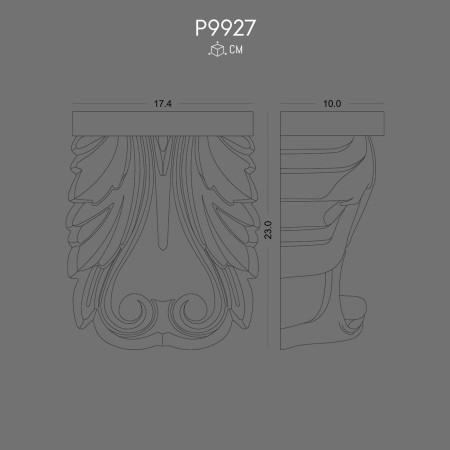



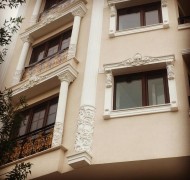





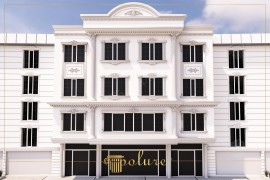

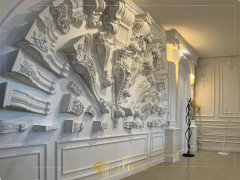
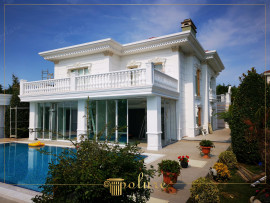
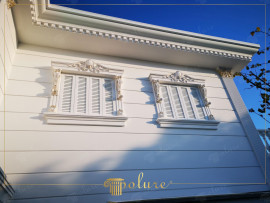
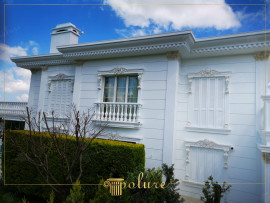
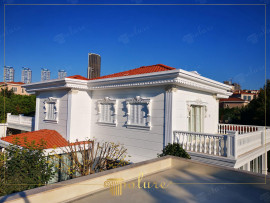
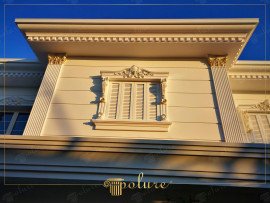
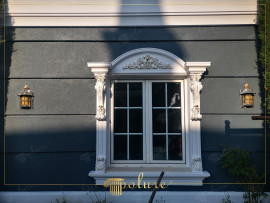
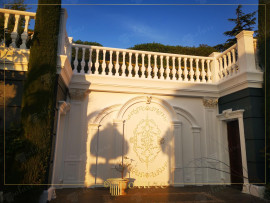



















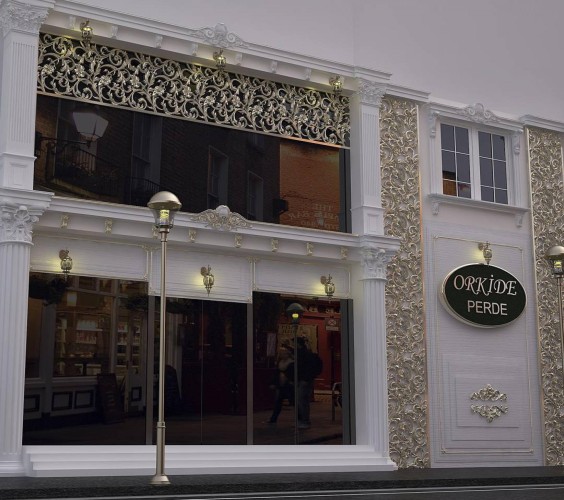
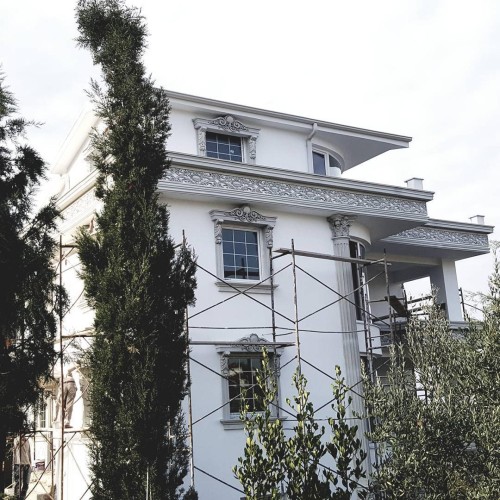

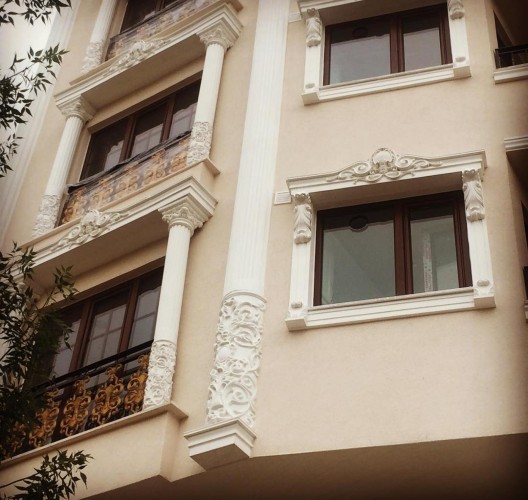
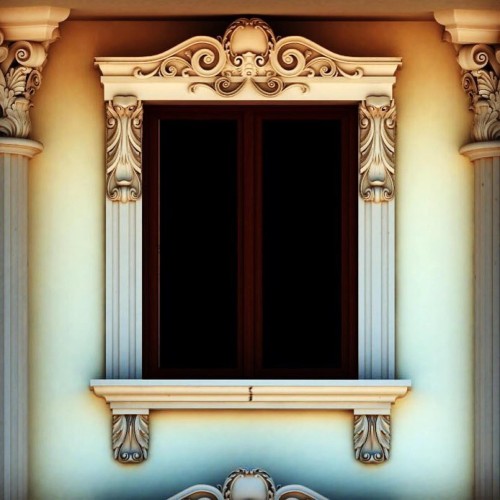
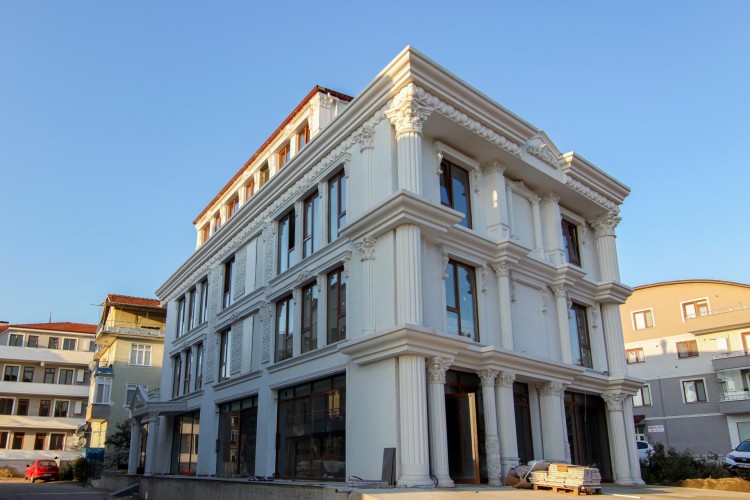

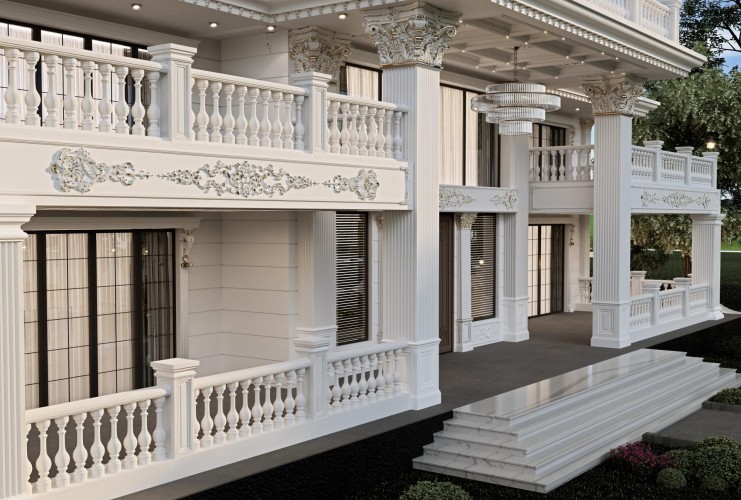

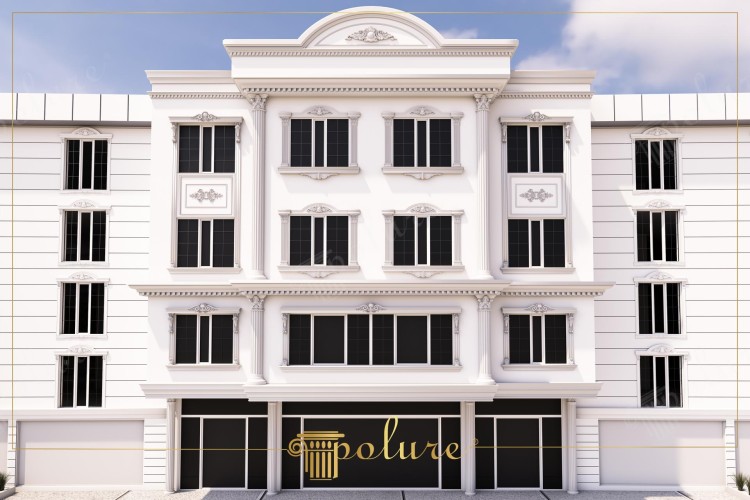



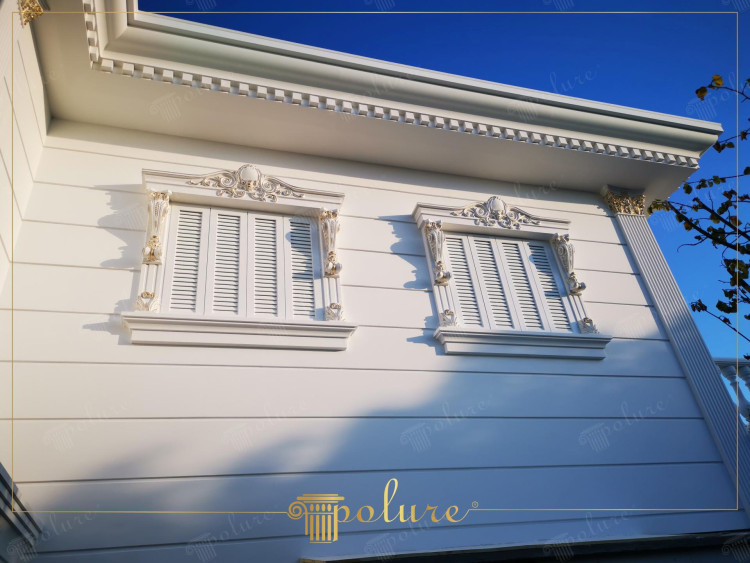

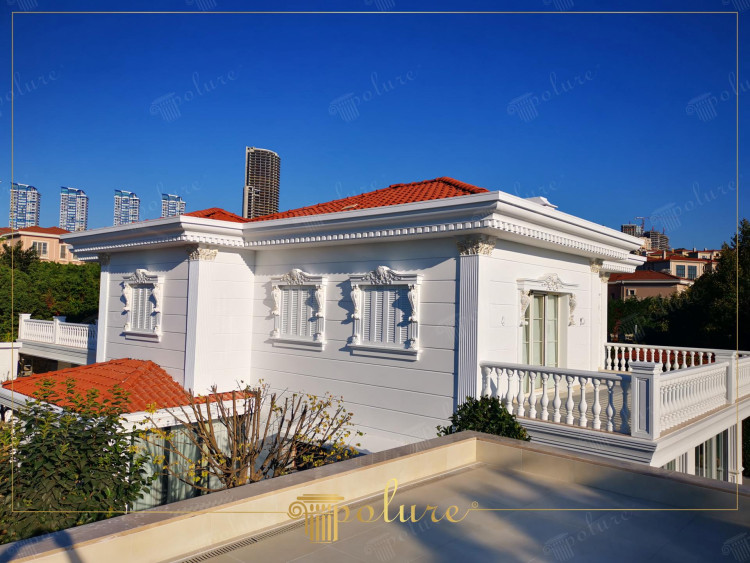


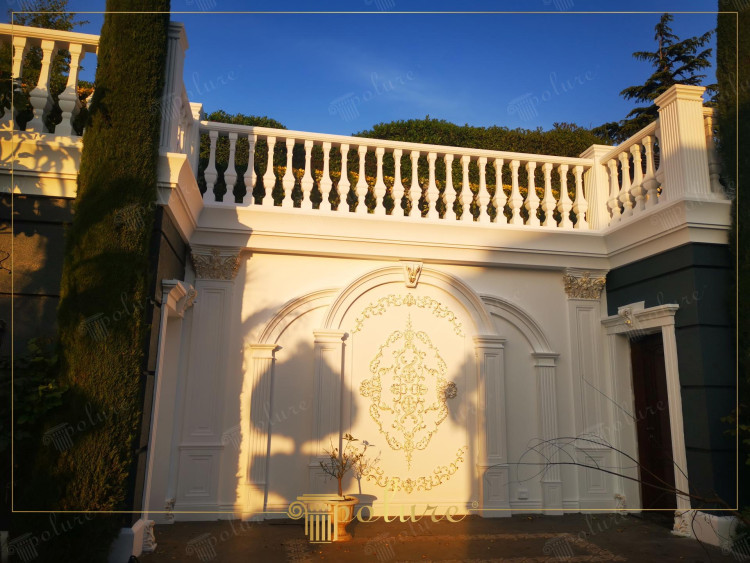















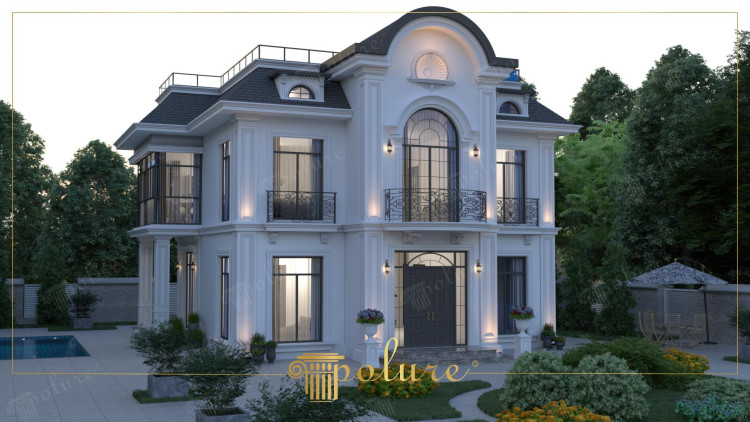
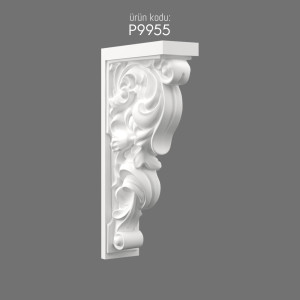
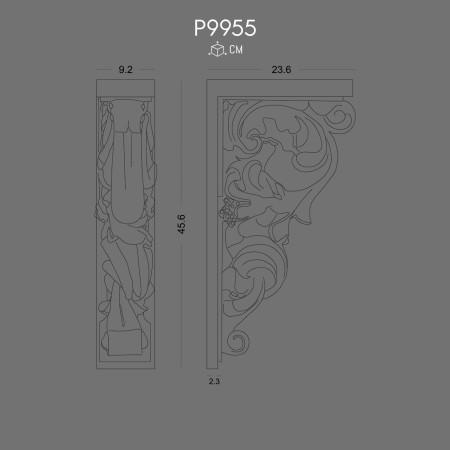

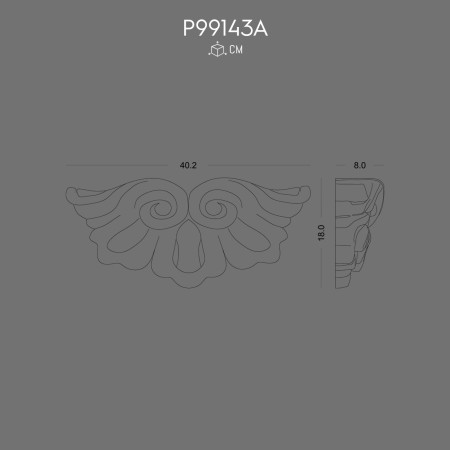
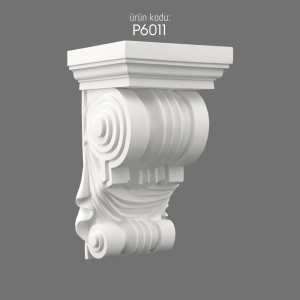
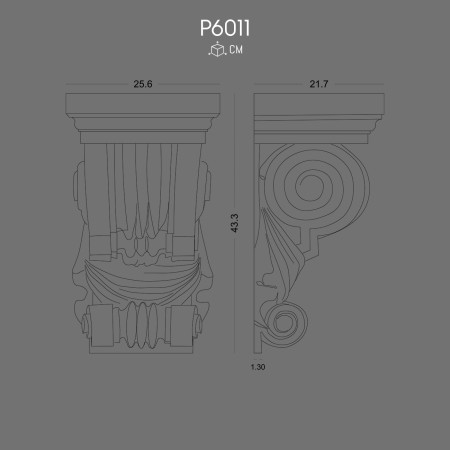
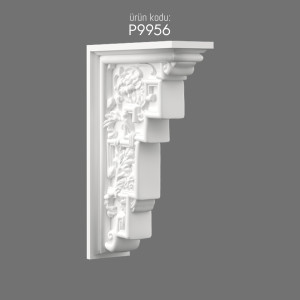
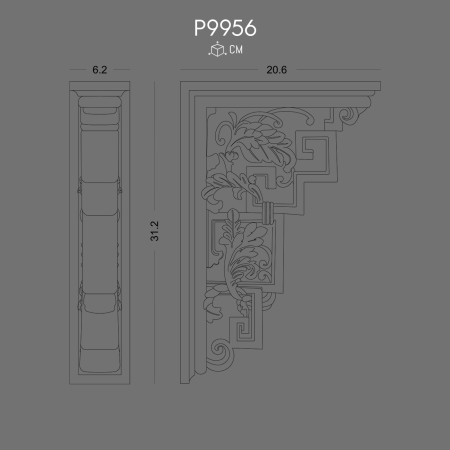


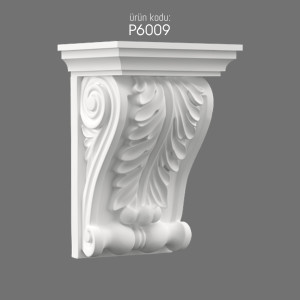
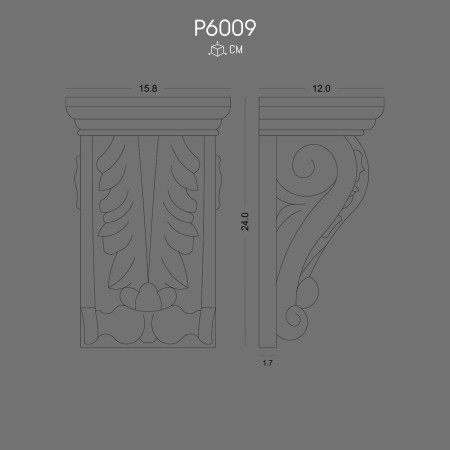


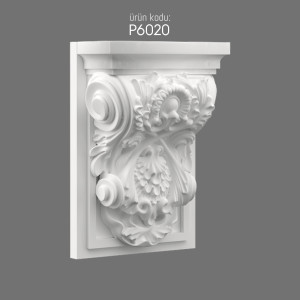

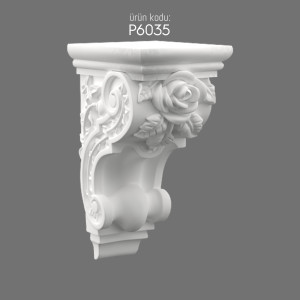
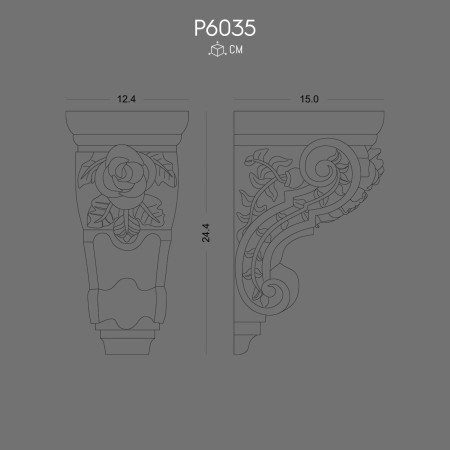
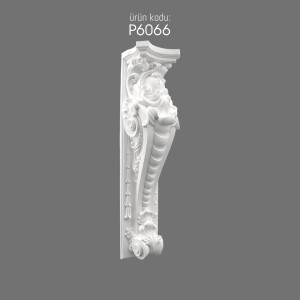
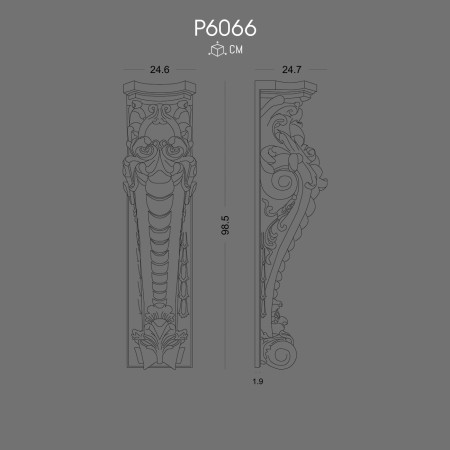
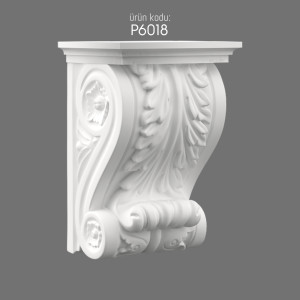
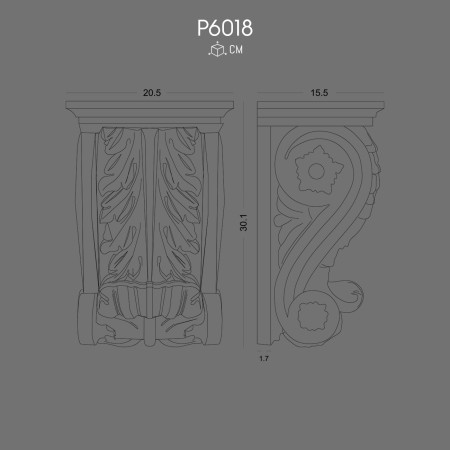
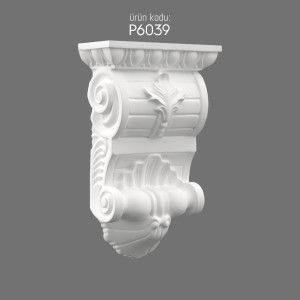
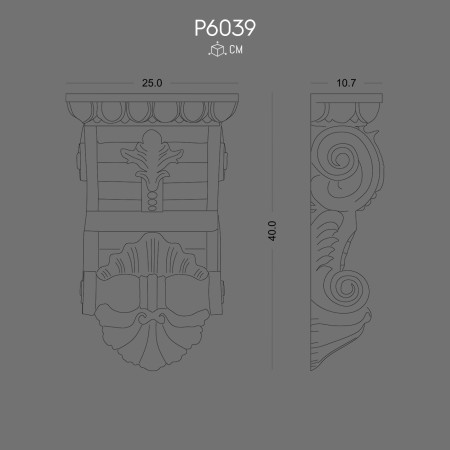
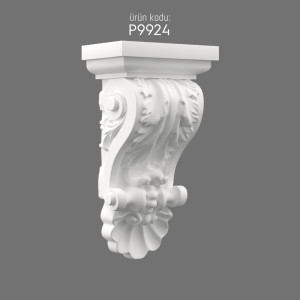
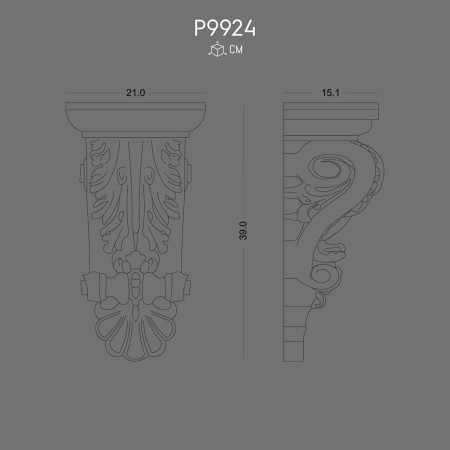

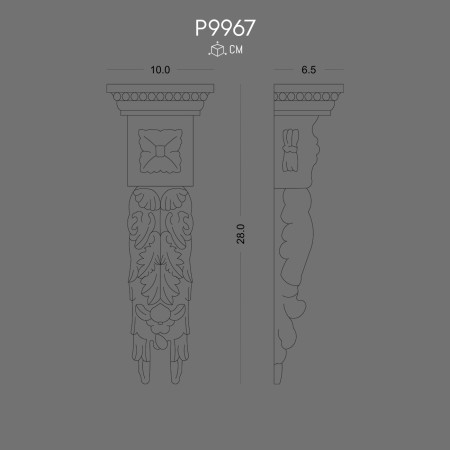
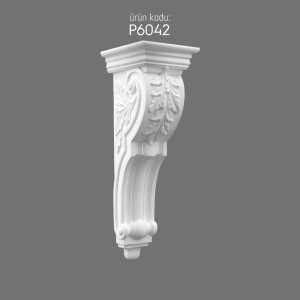

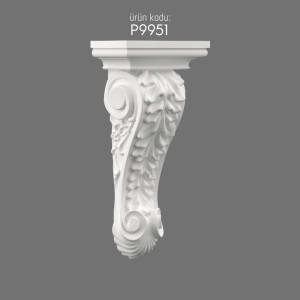
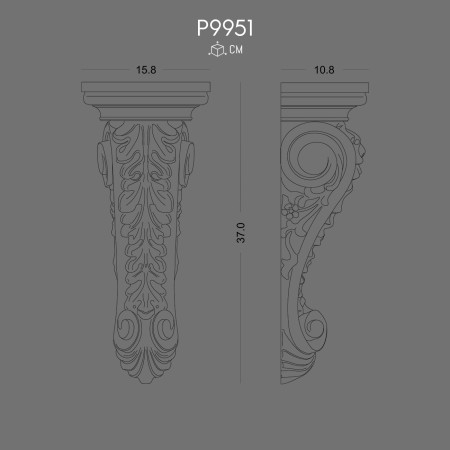
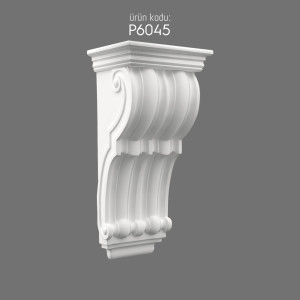
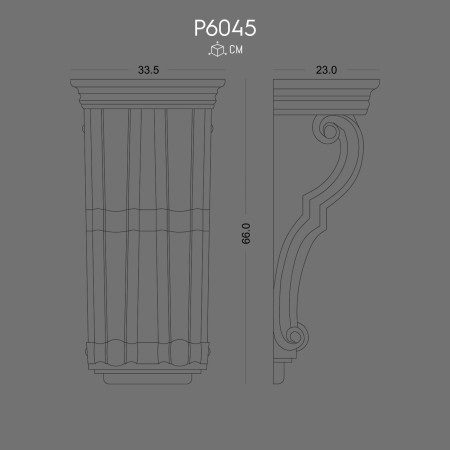
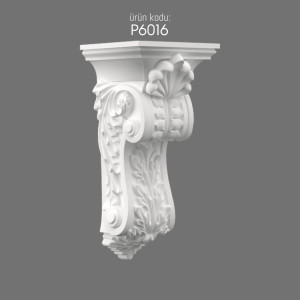
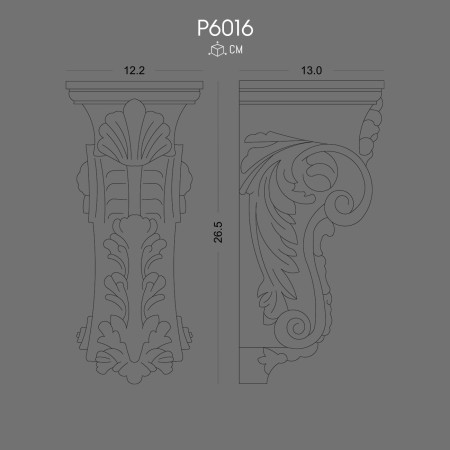

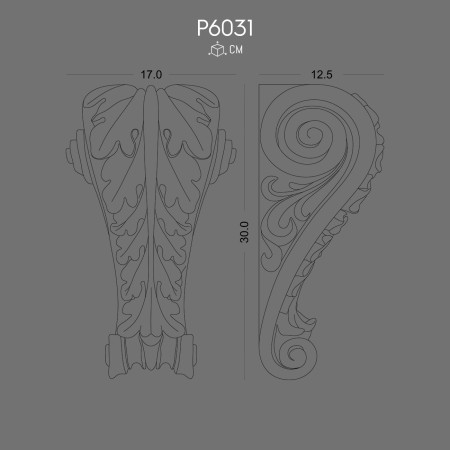


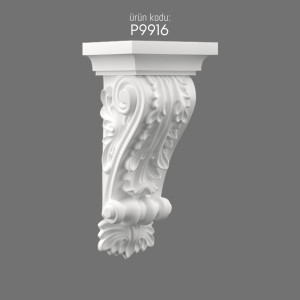
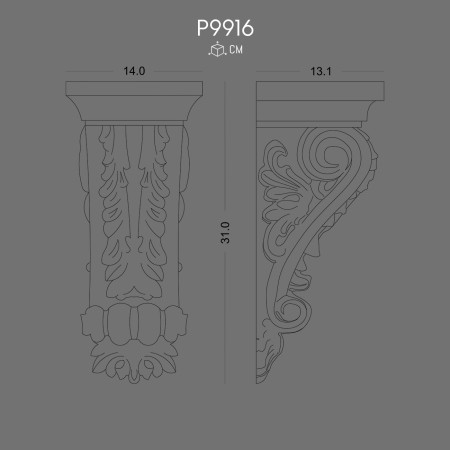
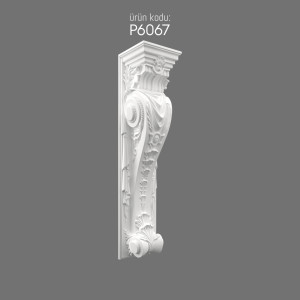
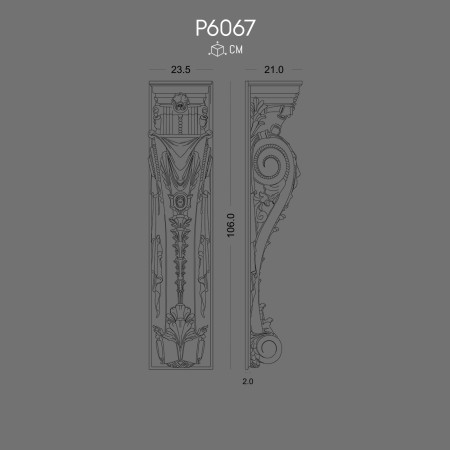
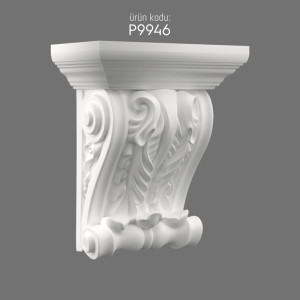
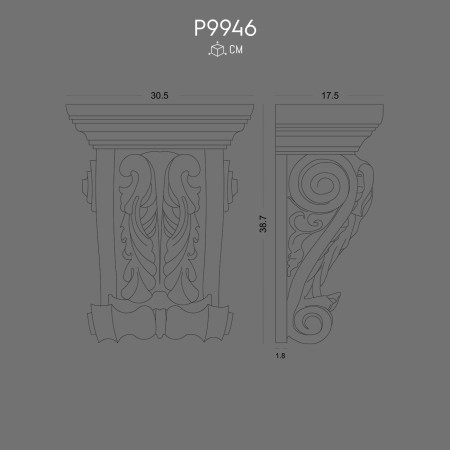
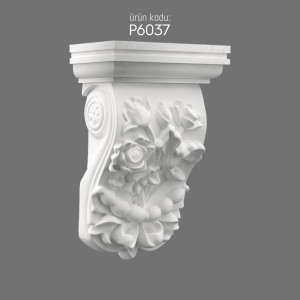
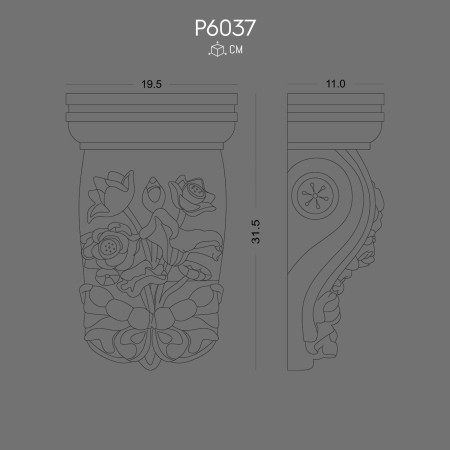
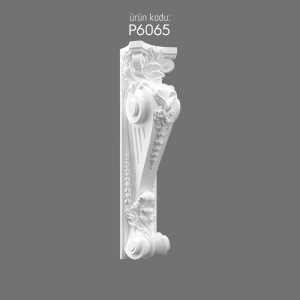
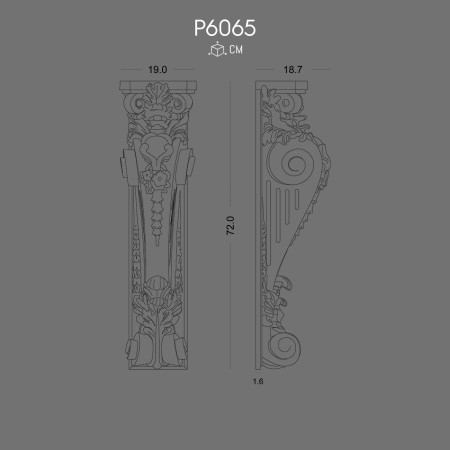
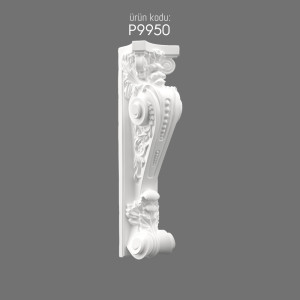
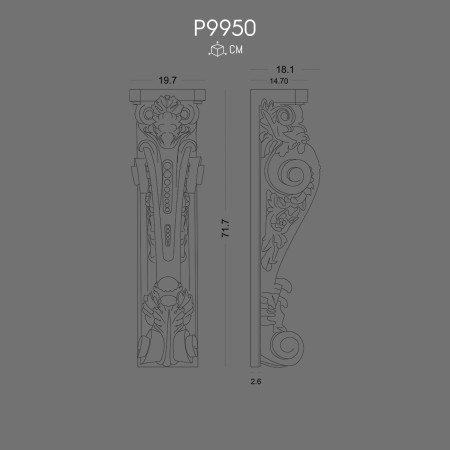

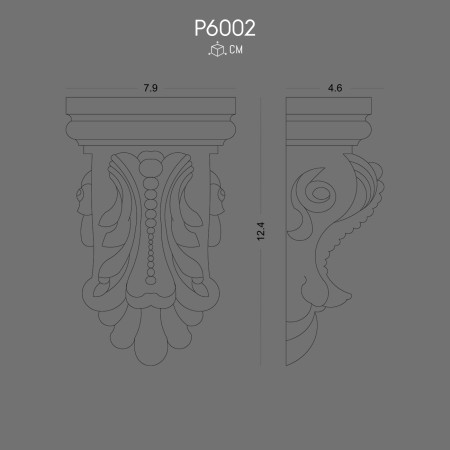

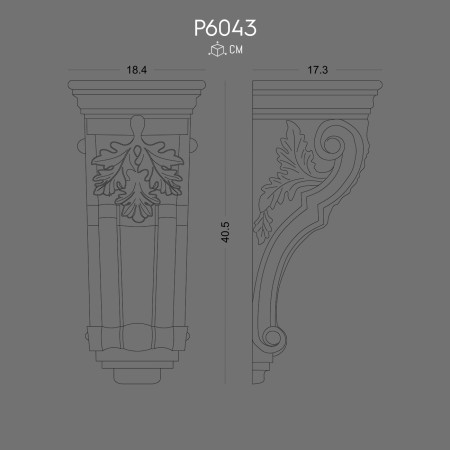
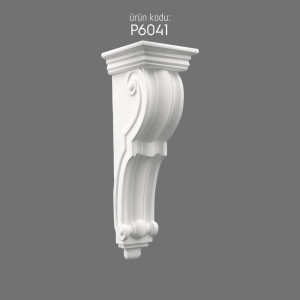
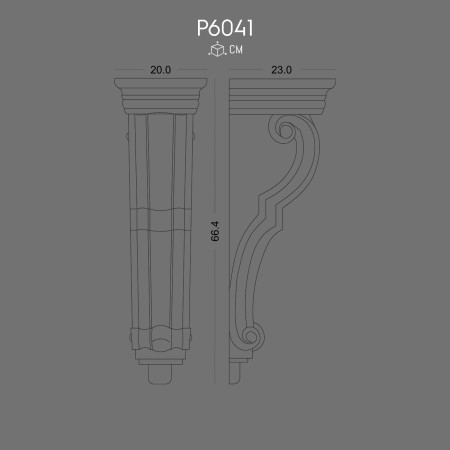
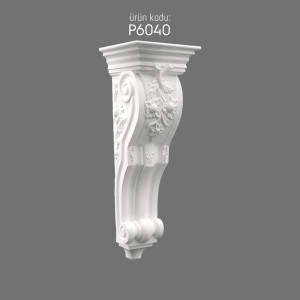
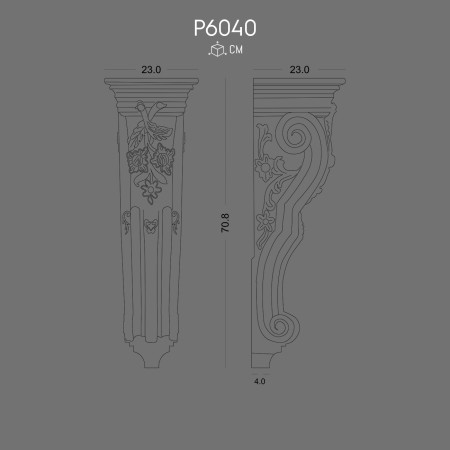
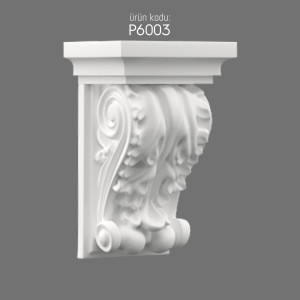
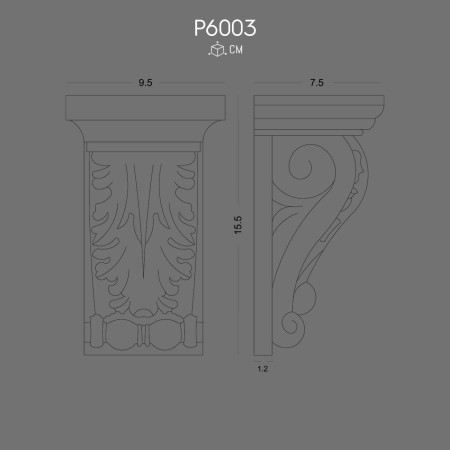
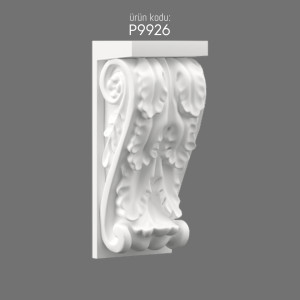
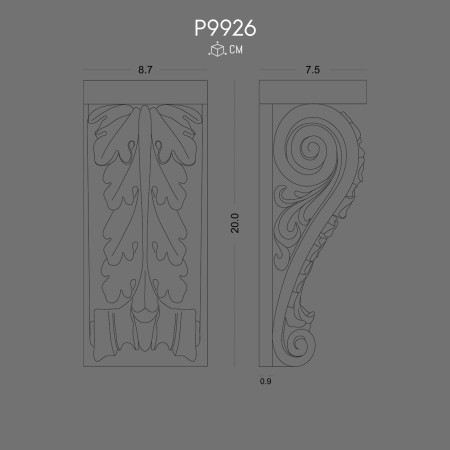
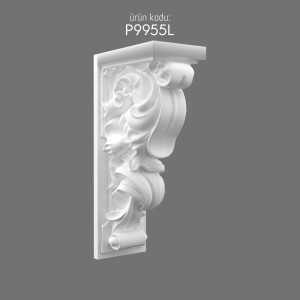
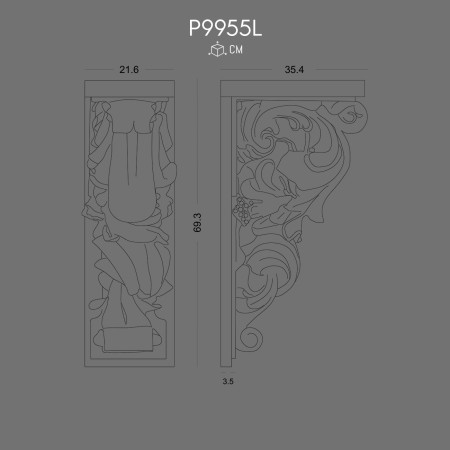

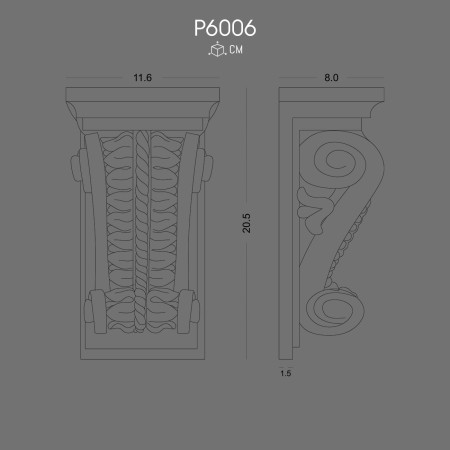
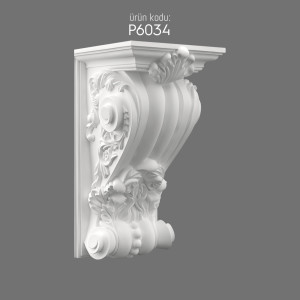
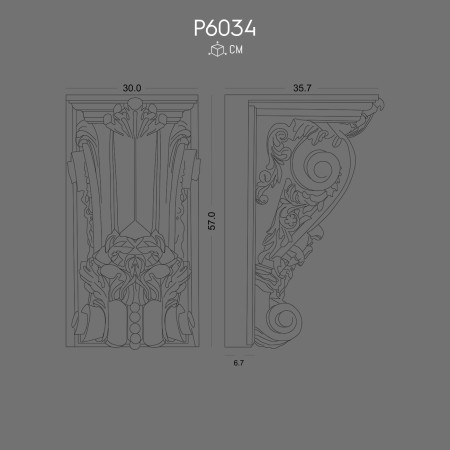


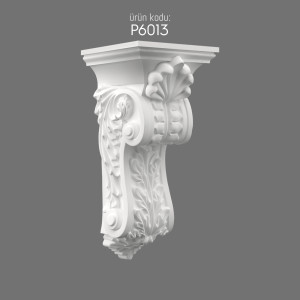
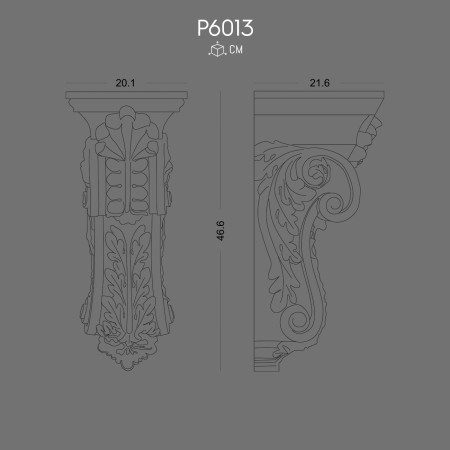
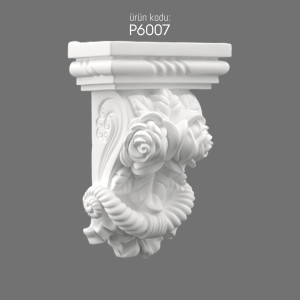
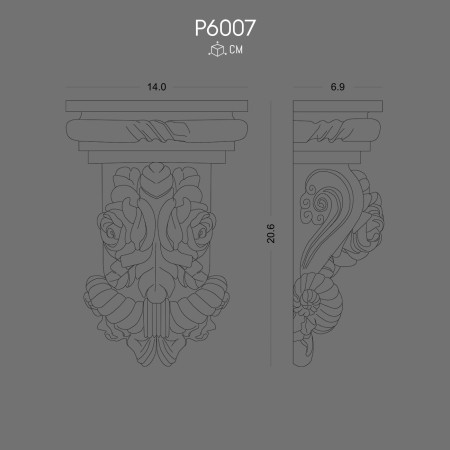
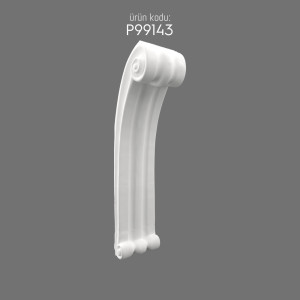
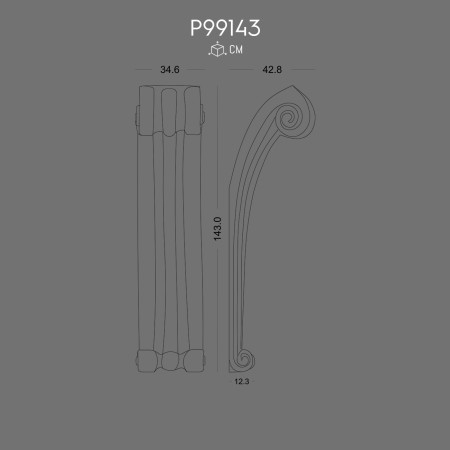

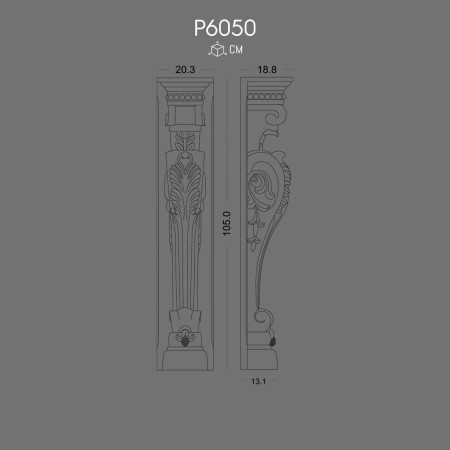











No reviews found for this product. Be the first to comment!